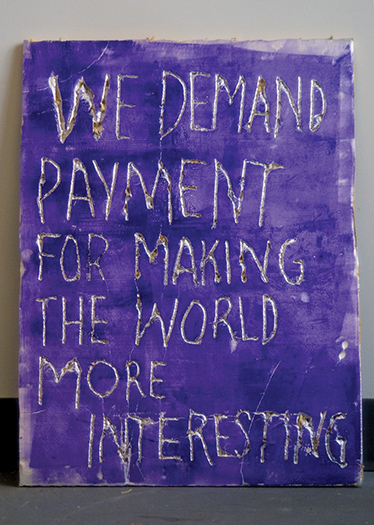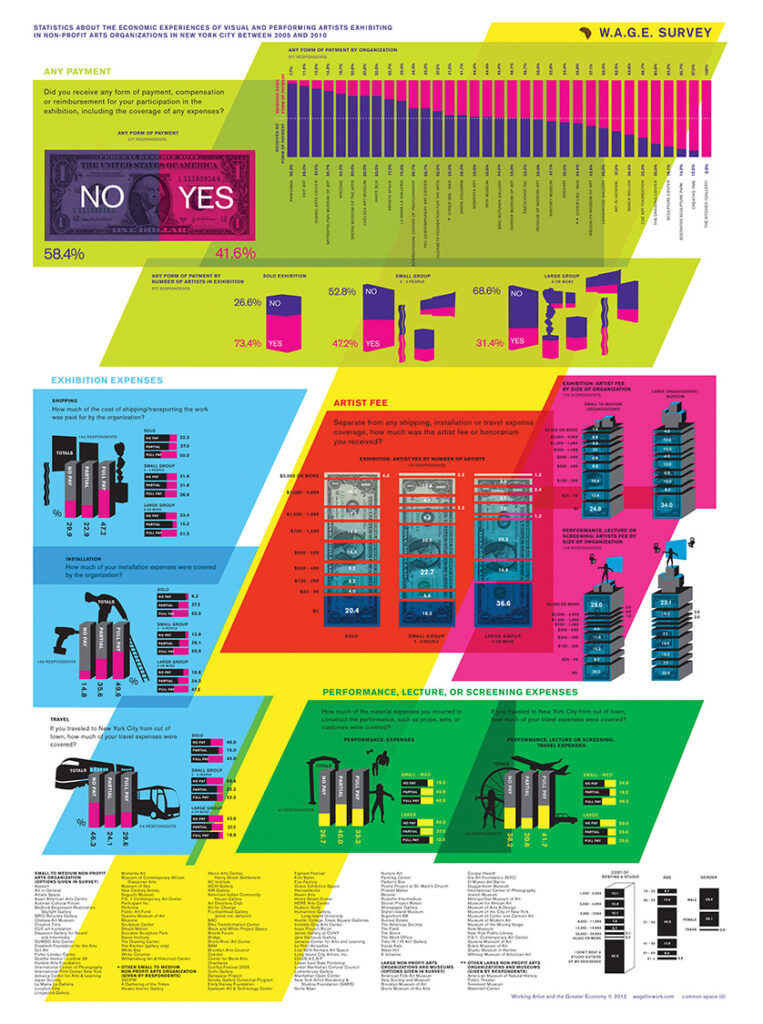Paying Artists, Equitably
Under the banner “Working Artists and the Greater Economy” (W.A.G.E.), a group of New York City-based artists, performers, and independent curators set out in 2008 to change what they knew empirically was an unfair payment structure for artists. With revolutionary overtones, W.A.G.E. announced its presence in a “womanifesto.” In nine bullets, the activists proclaimed their work, insights, and goals, opening with “W.A.G.E. works to draw attention to economic inequalities that exist in the arts, and to resolve them,” and closing with its aim of “developing an environment of mutual respect between artists and institutions.”

For four years, starting in fall 2010, W.A.G.E. (wageforwork.com) conducted extensive field research and engaged with a diverse arts
community and academicians, lawyers, and labor historians to develop a program that would spark and recognize equitable payment practices by nonprofit arts organizations.
In fall 2012, W.A.G.E. released the findings of its two-year-long online survey about the economic experiences of visual and performing artists exhibiting at nonprofit organizations in New York City between 2005 and 2010. The egregious data point: 58 percent of the 577 responding artists did not receive any form of payment, compensation, or reimbursement—including any coverage of expenses, for exhibiting or presenting their work at arts nonprofits. WA.G.E. now had a cudgel that documented the common practice of non-payment.
Upon its launch of WA.G.E. Certification in October 2014, the advocacy group promised “a paradigm-shifting model of the remuneration of artistic labor in the nonprofit sector.” They initiated a mechanism that, in their words, “enables both artists and institutions to collectively bring about a more equitable distribution of the arts-based economy.”
The policy and regulatory program certifies arts nonprofits that demonstrate a consistent commitment to voluntarily paying artists fees according to standardized rates. W.A.G.E.’s online calculator enables certified organizations to determine what to pay as a baseline for programs ranging from solo to group exhibitions and performances to talks, in-person appearances, and commissioned texts. The appropriate fees are calculated by a fixed percentage of the organization’s total annual operating expenses. Since W.A.G.E. requires a long-term commitment to its payment standards, only organizations are certified, not single exhibitions.
The current number of museums nationwide that have been certified since the program’s inception is 87. In 2017, Philadelphia’s Institute of Contemporary Art became the first W.A.G.E.-certified museum.
Brandeis University’s Rose Art Museum was the second museum to join the list, while MassArt Art Museum (MAAM) joined in 2018, before its opening in winter 2020.

Lise Soskolne, a co-founder of W.A.G.E. and its core organizer since 2012, says, “We have seen that artists are more inclined to work with a certified institution. But because there’s so much confusion around the question of payment, negotiation can be a difficult scenario for institutions to navigate. I think it’s a relief for a lot of institutions when they know exactly what they should pay. With certification comes clarity. And the joy of doing the right thing.”
In a field such as the visual and performing arts, negotiating is not a common operating procedure. W.A.G.E.’s second tool, WAGENCY, which launched in 2018, aims to make negotiating pervasive and impactful. When introducing the program, W.A.G.E. shared an insight born of its struggle for economic equity: “It turns out that an industry organized around profiting from unpaid labor requires more than a certification program to keep it in line—it requires artists to mobilize together as a workforce.” WAGENCY enlisted artists countrywide into the tussle, shifting some of the responsibility for ensuring fair pay from institutions to artists.
According to the release, WAGENCY “supplies artists with digital tools and the necessary collective agency to negotiate W.A.G.E. fees or withhold content from institutions when they refuse to pay according to W.A.G.E. standards.” By paying a monthly five-dollar fee, members of the program, called WAGENTS, can search a database of non-W.A.G.E.-certified institutions to develop a fee request according to W.A.G.E.’s calculation, and then submit that amount (or more) for their provision of content and services from the institutions that invite them to give a talk or show a work of art.
W.A.G.E. begins the negotiating process by submitting a fee request on the artist’s behalf to the arts organization. Since the artists act as contractors who decide their rates for themselves, the process gives them greater bargaining power. Soskolne reports that WAGENTS now number an encouraging 827, with artists from across the country, working in varied mediums.
Both the Rose and MAAM sought W.A.G.E. certification as an outgrowth of their missions and a further means of addressing equity issues. “The Rose Art Museum, was the second museum to join W.A.G.E.,” says Gannit Ankori, Henry and Lois Foster Director and Chief Curator, “and I am proud of that fact. Our commitment to W.A.G.E represents a crucial step towards achieving our goal of becoming a more equitable, inclusive, and just museum. The Rose is deeply committed to values of social justice: a mission shared with Brandeis University. Paying artists a fair wage for their labor is an extension of our commitment and is a matter of principle.”
Anthony DiPietro, the Rose’s associate director, administration and operations, and its DEIA Partner, says, “The decision to join W.A.G.E. was driven by a desire to ‘walk the talk’ when it comes to social justice values, a set of values that have always been part of the museum’s DNA. But it was a concrete and visible step that continues to be good for the museum while also helps protect artists and ensure equitable pay.”
Lisa Tung, MAAM’s executive director says, “MAAM offers free admission as a way of offering access to contemporary art, but another important aspect of access is creating equitable opportunities for artists and art students. We pay all our student workers in order to provide pathways to careers in the arts, and we compensate artists according to W.A.G.E. standards. As a teaching museum we believe it’s our responsibility to show our students and the public what working artists do and that the jobs of artist, designer, and educator are viable careers as well as valuable contributors to our culture and our economy.”
When MAAM opened in winter 2020, it featured a site specific installation called “Yesterday is Here,” by the collective Ghost of a Dream. The artists, Lauren Was and Adam Eckstrom, were informed at the onset that MAAM would adhere to W.A.G.E. structures.
“We were so happy that MAAM had adopted the W.A.G.E. guidelines,” says the duo. “We love to see that there is a standard being taken on to help the situation that usually leaves artists shortchanged. MAAM is quite dedicated to treating artists fairly and appropriately and offering equitable employment and education, and we look to the institution and other W.A.G.E. members with great respect for adhering to these standards.”
While closed to the public during the pandemic, both the Rose and MAAM upheld the tenets of W.A.G.E, paying artists and guest speakers for participating in their online programming. Acknowledging that the fraught times had re-stirred economic and racial issues, Soskolne says, “Since the onset of the COVID-19 pandemic and ensuing economic crisis, followed by the long overdue global uprisings for racial justice, it has become clear that activism is now central to the daily lives of many more people. It is also clear that there is an urgent need in the cultural sector for organizational structures and tools that effectively move us toward racial and economic equity.”
As its adherents increase, albeit slowly, W.A.G.E. is developing Artists’ Contracts, a third arm of its platform, which will offer interactive agreements, contracts, and riders for artists and institutions. The advocacy group’s continued expansion and innovation gives artists the welcomed opportunity to evolve their expressive avocations into consequential and sustainable vocations. Considering all of it—the creative work plus the struggle to survive—we the people in the general economy would benefit by taking to heart and mind the final assertion of its 2008 womanifesto: “W.A.G.E. demands payment for making the world more interesting.”
